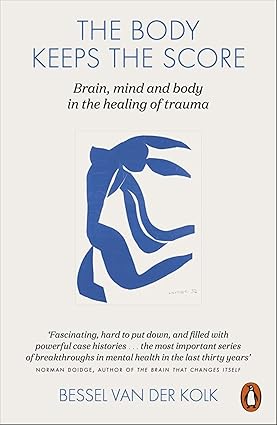Buy Here – Amazonhttps://amzn.to/44j5RIt

The Body Keeps the Score – Bessel van der Kolk
Trauma doesn’t just haunt the mind — it settles into the body. In his groundbreaking book The Body Keeps the Score, psychiatrist Dr. Bessel van der Kolk explains how traumatic experiences reshape both the brain and body, and how healing often requires more than just talk therapy.
This book is widely considered one of the most comprehensive resources on trauma, blending neuroscience, clinical experience, and stories of recovery. It’s a must-read for mental health professionals, trauma survivors, and anyone interested in understanding how the human body processes pain and resilience.
What Is Trauma According to Van der Kolk?
Dr. van der Kolk describes trauma as a deeply distressing or disturbing experience that overwhelms the nervous system. It could be caused by childhood abuse, domestic violence, war, accidents, or neglect. Over time, trauma affects memory, behavior, and even physical health.
“Trauma is not just an event that took place sometime in the past; it is also the imprint left by that experience on mind, brain, and body.”
→ This is a direct quote from the book.
Key Insights from “The Body Keeps the Score”
- The Brain and Trauma: Traumatic memories are stored differently in the brain — particularly in the amygdala and hippocampus — making them difficult to process verbally.
- The Body Remembers: Even if someone can’t consciously recall a traumatic event, their body may still react to triggers — a concept known as “somatic memory.”
- Traditional Talk Therapy Isn’t Always Enough: Van der Kolk emphasizes the limitations of purely cognitive approaches. He advocates for body-based therapies such as yoga, EMDR (Eye Movement Desensitization and Reprocessing), and neurofeedback.
- Childhood Trauma Has Lifelong Impact: Adverse childhood experiences (ACEs) are linked to higher rates of physical illness, addiction, and mental disorders in adulthood.
- Connection Heals: Safe relationships, mindfulness, and community are vital for trauma recovery.
How Trauma Manifests in the Body
Trauma can show up as:
- Chronic pain
- Digestive issues
- Migraines
- Fatigue
- Autoimmune disorders
This is because the nervous system remains in a prolonged state of fight, flight, or freeze. The body is trying to protect itself, even long after the danger has passed.
Healing from Trauma
Van der Kolk emphasizes that healing is possible, but it often requires integrating the body into treatment. Techniques include:
- Yoga: Helps regulate breathing, calm the nervous system, and rebuild body awareness.
- EMDR: A therapy that helps reprocess traumatic memories.
- Neurofeedback: Brain training that helps regulate emotional responses.
- Mindfulness & Meditation: Increases present-moment awareness and reduces reactivity.
Who Should Read This Book?
- Trauma survivors seeking understanding and hope
- Therapists, psychologists, and counselors
- Educators and caregivers working with at-risk populations
- Anyone curious about the mind-body connection
Sources / Scientific References
- Van der Kolk, B. (2014). The Body Keeps the Score: Brain, Mind, and Body in the Healing of Trauma. Viking.
- American Psychological Association. (2023). Trauma. https://www.apa.org/topics/trauma
- Siegel, D. J. (2010). The Mindful Therapist. Norton.
- Shapiro, F. (2001). Eye Movement Desensitization and Reprocessing (EMDR), Basic Principles, Protocols, and Procedures. Guilford Press.
- National Child Traumatic Stress Network. (2023). Impact of Complex Trauma. https://www.nctsn.org/